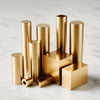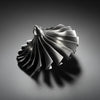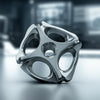CNC Machining Cost Optimization Without Sacrificing Quality

How to Optimize CNC Costs: Actionable Strategies
1. Design for Manufacturability (DFM)
Smart design choices directly reduce cycle times and tool wear:
-
Avoid Deep Pockets & Cavities: Limit depths to ≤4× the tool diameter. Deeper features require fragile extended-reach tools or slower multi-pass machining.
-
Increase Wall Thickness: Design metal walls >0.8 mm and plastic walls >1.5 mm to avoid vibration, breakage, and multi-pass finishing.
-
Use Standard Features: Adopt standard drill sizes, thread lengths (≤3× hole diameter), and internal corner radii (≥⅓ cavity depth).
-
Minimize Tolerances: Specify tight tolerances (±0.025 mm or less) only for critical features. Looser tolerances (±0.125 mm) cut costs by 15–30% by enabling faster machining and reducing QC needs.
-
Reduce Setups: Design parts machinable in 1–2 setups. Each repositioning adds labor and potential errors.
2. Material Selection & Utilization
-
Choose Machinable Materials: Aluminum 6061, mild steel, or engineering plastics (like ABS) cut 20–40% faster than stainless steel or titanium.
-
Match Stock Sizes: Design parts within 3 mm of standard billet dimensions (e.g., 0.49" instead of 0.53" aluminum) to minimize waste and milling time.
-
Nesting Optimization: Use CAD software to arrange parts efficiently on raw stock, reducing scrap by 5–10%.
Table: Cost and Machinability of Common CNC Materials
| Material | Relative Cost | Machinability Rating | Ideal Use Cases |
|---|---|---|---|
| Aluminum 6061 | Low | Excellent | Prototypes, enclosures |
| Mild Steel | Medium | Good | Structural parts |
| Stainless Steel | High | Moderate | Corrosion-resistant components |
| Titanium | Very High | Poor | Aerospace, medical implants |
| POM (Acetal) | Medium | Excellent | Gears, bearings |
3. Process & Technology Upgrades
-
High-Speed Machining (HSM): Uses high spindle speeds and shallow cuts to reduce cycle times by 10–25% for aluminum or plastics.
-
Multi-Axis Machines: 5-axis CNC systems machine complex shapes in one setup, cutting labor by 30% and improving accuracy.
-
Toolpath Optimization: Adaptive clearing or trochoidal milling distributes tool load evenly, extending tool life by 20%.
-
Automation: Robotic loading/unloading and CAM-driven workflows minimize labor and errors, especially for batches >1,000 units.
4. Operational Efficiency
-
Preventive Maintenance: Calibrated machines and sharp tools reduce scrappage by 5–15% and avoid costly downtime.
-
Bulk Ordering: Leverage economies of scale—batches of 1,000+ units can lower per-part costs by up to 40%.
-
Supplier Partnerships: Negotiate bulk material pricing or outsource specialty operations (e.g., EDM) to avoid in-house investment.
Results and Benefits: Data-Driven Outcomes
Implementing these strategies delivers measurable ROI:
-
Cost Reduction: Manufacturers report 10–30% lower machining expenses through design tweaks and process optimization.
-
Sustainability Gains: A Zhejiang University study cut carbon emissions by 10.4% and costs by 13.8% using optimized parameters.
-
Quality Consistency: Automated inspection (CMM/laser scanning) reduces rework by up to 25%.
Table: Impact of Key Optimization Strategies
| Strategy | Cost Reduction | Additional Benefit |
|---|---|---|
| Design Standardization | 15–20% | Faster production setup |
| Material Optimization | 10–15% | 5–10% less scrap |
| High-Speed Machining | 10–25% | Shorter lead times |
| Tight Tolerance Elimination | 15–30% | Simplified QC |
Conclusion: Balance Cost and Capability
CNC machining doesn’t have to be prohibitively expensive. By designing smarter, leveraging technology, and optimizing workflows, manufacturers achieve 30%+ cost savings without compromising quality. Partner with experienced machinists early in the design phase—their input on manufacturability often uncovers the quickest wins
-
Posted in
cnc machining, machining cost, precision machining





